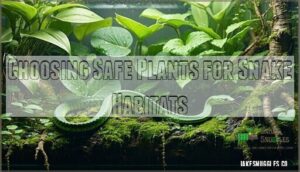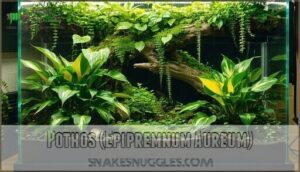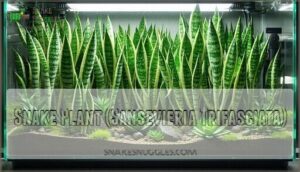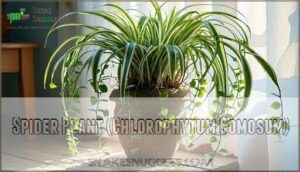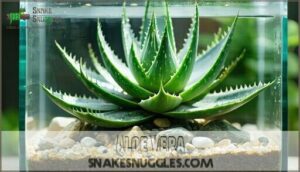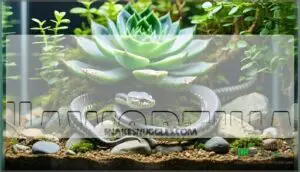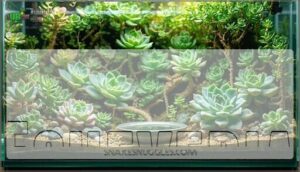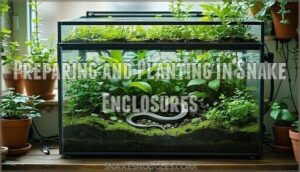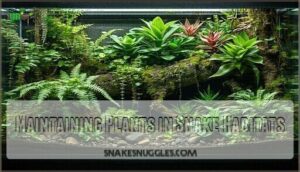This site is supported by our readers. We may earn a commission, at no cost to you, if you purchase through links.

Pothos, spider plants, and snake plants top the list because they’re virtually bulletproof and handle humidity changes like champs. For desert species, aloe vera and haworthia work beautifully without creating moisture issues.
Jade plants and dwarf schefflera add natural climbing opportunities, while bromeliads create those perfect hiding spots your snake craves.
Always quarantine new plants for two weeks to avoid introducing pests or harmful chemicals. The key isn’t just picking pretty plants—it’s understanding how each species interacts with your snake’s specific environmental needs and behavioral patterns.
Table Of Contents
- Key Takeaways
- Benefits of Live Plants in Snake Enclosures
- Choosing Safe Plants for Snake Habitats
- Top Tropical Plants for Snake Cages
- Best Arid Plants for Desert Snake Terrariums
- Preparing and Planting in Snake Enclosures
- Maintaining Plants in Snake Habitats
- Adapting Plant Care for Different Snake Species
- Frequently Asked Questions (FAQs)
- Can you put plants in a snake cage?
- What plants are safe for reptile cages?
- What kind of plants can go in a ball python enclosure?
- What house plants are safe for snakes?
- How often should I replace plants in my snakes enclosure?
- Can snakes eat or digest enclosure plants accidentally?
- Will plant fertilizers harm my snake?
- How do I prevent mold growth on enclosure plants?
- Are air plants suitable for snake habitats?
- Can snakes eat or digest live plants safely?
- Conclusion
Key Takeaways
- You’ll want to stick with proven non-toxic plants like pothos, spider plants, and snake plants since they’re bulletproof choices that handle humidity changes while keeping your snake safe from accidental ingestion.
- Choose plants based on your snake’s natural habitat—use drought-tolerant succulents like aloe vera and haworthia for desert species, or humidity-loving tropical plants like bromeliads for ball pythons and boas.
- Always quarantine new plants for two weeks before adding them to your snake’s enclosure to prevent introducing pests, harmful chemicals, or diseases that could affect your pet’s health.
- You’ll need proper drainage and soil preparation to prevent root rot and substrate contamination, plus regular maintenance like pruning overgrowth and monitoring for pests to keep both plants and snake thriving together.
Benefits of Live Plants in Snake Enclosures
Adding live plants to your snake’s enclosure creates a natural environment that improves air quality, regulates humidity through transpiration, and provides essential hiding spots that reduce stress.
Transform your snake’s home into a living ecosystem where plants and serpents thrive together naturally.
You’ll notice your snake behaves more naturally in planted terrariums, while the plants help manage waste by absorbing nitrogen compounds from urates and droppings, which contributes to a healthier planted terrariums.
Natural Habitat Replication
Live plants transform your snake’s cage into a naturalistic enclosure that mirrors their wild home.
This enclosure enrichment supports species-specific needs, whether your python craves tropical foliage or your kingsnake prefers desert succulents.
Strategic snake enclosure landscaping creates proper ecosystem balance, encouraging natural behaviors like hunting and hiding.
To guarantee safety, choose plants that avoid sharp thorns.
Your serpent will exhibit confident behavioral benefits in this authentic snake habitat design.
Humidity Regulation
Through the magic of plant transpiration, your snake enclosure plants become natural humidity controllers.
They release moisture into the air, creating perfect conditions for tropical species without constant misting frequency adjustments.
Here’s how vivarium plants maintain ideal snake humidity:
- Water retention in leaves slowly releases moisture throughout the day
- Substrate moisture gets regulated as roots absorb excess water
- Air circulation improves as plants create natural ventilation patterns
Your snake vivarium practically manages itself!
Aesthetic Enclosure Enhancement
Why settle for a bland snake cage when naturalistic snake enclosure design transforms your pet’s home into stunning artwork?
Live plants create visual harmony through varied plant textures and natural color palettes.
Strategic placement establishes focal points that enhance snake enclosure aesthetics.
This naturalistic design approach with carefully chosen snake enclosure plants turns functional snake enclosure decoration into engaging living displays.
Choosing Safe Plants for Snake Habitats
When you’re selecting plants for your snake’s terrarium, you’ll need to research each species carefully since some common houseplants can be toxic if your snake accidentally nibbles on them.
You’ll also want to evaluate the plant’s structure, growth pattern, and environmental needs to verify it won’t create problems like sharp edges, excessive moisture, or compete with your snake’s habitat requirements, ensuring a safe and healthy environment for your snake.
Non-toxic Species
When choosing snake enclosure plants, plant toxicity becomes your top priority.
You’ll need species compatibility verification before introducing any vegetation to prevent ingestion risks.
Consider these reptile safe plants for peace of mind:
- Spider plants – completely nontoxic and virtually indestructible
- Pothos varieties – safe alternatives that thrive in humid conditions
- Snake plants – ironically perfect safe plants for snakes.
Always seek veterinary verification for snake terrarium plants.
Live plants also offer environmental enrichment for snakes.
Structural Considerations
Plant placement demands careful attention to your snake’s physical needs.
Select species with sturdy root systems that won’t topple when your snake moves through the enclosure.
Avoid thorny varieties that could injure delicate scales.
Consider enclosure size when choosing climbing support—tall plants work well in spacious snake terrariums, while compact varieties suit smaller snake vivarium setups.
Make certain adequate light access for healthy growth.
Prioritize your snake’s well-being by choosing plants with known toxicity levels.
Environmental Impact
Beyond plant safety, you’ll want to take into account their environmental impact on your snake enclosure’s ecosystem.
Select species that provide ecosystem services like carbon sequestration and waste reduction through natural processes.
Source plants sustainably to support habitat enrichment without disrupting local environments.
Your snake terrarium becomes a mini-ecosystem where proper plant choices create balanced, thriving conditions for your reptile companion.
Top Tropical Plants for Snake Cages
When you’re setting up a tropical snake enclosure, you’ll want plants that can handle high humidity, warm temperatures, and the occasional curious serpent brushing against their leaves.
The three champions for tropical snake cages—pothos, snake plants, and spider plants—aren’t just safe for your scaly friend, they’re practically bulletproof in regard to thriving in the steamy, 80-degree environment your ball python or boa calls home.
Pothos (Epipremnum Aureum)
Golden pothos thrives as the ultimate beginner-friendly choice for snake vivarium plants.
This nontoxic plant adapts to various lighting needs while tolerating humidity changes that make other plants struggle.
- Pothos varieties like marble queen and jade offer diverse visual appeal for your enclosure
- Pothos propagation happens easily through stem cuttings in water or soil
- Toxicity levels remain completely safe if your snake accidentally nibbles the leaves
Snake Plant (Sansevieria Trifasciata)
Most snake owners find Sansevieria varieties perfect for their enclosures. These nontoxic plants offer exceptional drought tolerance and air purification benefits.
Their vertical growth pattern creates natural hiding spots without crowding your terrarium.
Here’s what makes snake plant care so simple:
- Thrives in low light conditions typical of snake enclosures
- Requires minimal watering, preventing substrate oversaturation
- Tolerates soil acidity changes better than most snake enclosure plants
Spider Plant (Chlorophytum Comosum)
Moving beyond sturdy snake plants, spider plants offer exceptional versatility for your reptile’s home.
These non-toxic champions excel at air purification while tolerating various lighting conditions. Their cascading babies create natural climbing opportunities, encouraging healthy snake interaction behaviors.
Like spider plants, golden pothos thrives in humid conditions, making it another excellent option for snake enclosures.
| Care Aspect | Requirements |
|---|---|
| Lighting needs | Bright, indirect light preferred |
| Watering | Weekly when soil feels dry |
| Propagation methods | Remove plantlets from runners |
| Snake interaction | Safe for contact and climbing |
| Variety selection | ‘Vittatum’ and ‘Variegatum’ work best |
Best Arid Plants for Desert Snake Terrariums
If you’re setting up a desert terrarium for species like gopher snakes or California kingsnakes, you’ll need drought-tolerant plants that thrive in low-humidity environments while staying completely safe for your snake.
These hardy succulents, including aloe vera, haworthia, and echeveria, store water in their thick leaves and require minimal care, making them perfect companions for desert-dwelling reptiles that prefer arid conditions.
Aloe Vera
Aloe vera stands out as the gold standard for snake terrarium plants.
This desert champion thrives in arid conditions while providing air purification benefits.
Choose from various Aloe varieties suited to your snake enclosure plants setup.
Well-draining soil requirements prevent root rot, and simple propagation methods let you expand your collection easily.
Haworthia
While aloe vera thrives in bright desert conditions, Haworthia varieties prefer gentler lighting needs, making them perfect snake terrarium plants.
These compact snakesafe plants won’t overwhelm your enclosure with aggressive growth patterns.
Here’s why Haworthia excels as snake habitat plants:
- Simple watering techniques – drought-tolerant with forgiving care schedules
- Diverse propagation methods – easy offset division for expanding your collection
- Adaptable soil composition – thrives in standard succulent snake enclosure plants mix
Echeveria
Beyond their stunning rosette formations, Echeveria varieties bring vibrant colors to your snake enclosure.
These succulent plants require well-draining Echeveria soil and bright Echeveria lighting. Echeveria watering stays minimal—perfect for desert setups.
Ensuring the plants are non-toxic plant species is essential for the snake’s safety.
Echeveria propagation happens easily through leaf cuttings, making them cost-effective snake safe plants.
| Care Aspect | Requirement |
|---|---|
| Lighting | Bright, indirect sunlight |
| Watering | Monthly or less |
| Soil Type | Well-draining cactus mix |
| Propagation | Leaf cutting method |
Preparing and Planting in Snake Enclosures
You’ll need proper soil, drainage, and planting methods to create a thriving plant environment that won’t harm your snake’s health.
Setting up plants correctly from the start prevents root rot, substrate contamination, and guarantees your green additions survive regular snake activity without creating maintenance headaches, ensuring a healthy environment with proper care.
Soil Selection
You’ll want to pick soil that drains well for your snake enclosure while matching your pet’s natural habitat.
Mix equal parts perlite, coco coir, and sand for ideal drainage needs. Check soil pH stays between 6.0-7.5, and always sterilize components before use.
Skip fertilized potting mixes – they can harm reptiles. Using reptile-safe soil is vital for the health of your pet.
Organic matter supports healthy live plants without compromising your snake’s safety.
Drainage Considerations
Proper drainage prevents water pooling disasters that’ll turn your snake terrarium plants into soggy messes.
Without adequate drainage materials, you’re setting up root rot central—nobody wants that headache.
To guarantee a healthy environment, consider terrarium drainage solutions.
Here’s your drainage game plan:
- Substrate layering starts with gravel or clay pebbles at the bottom
- Bioactive drainage requires mesh barriers separating drainage from soil layers
- Snake enclosure plants need containers with drainage holes to prevent waterlogging
Planting Techniques
With proper drainage sorted, you’re ready to install your snake enclosure plants.
Layering substrate creates the foundation—place heavier rocks first, then lighter soil.
Use container choices like hidden pots for easy plant installation and maintenance.
Root protection prevents damage from curious snakes, while thoughtful planting density and vertical planting maximize your snake vivarium setup without overcrowding your reptile’s space.
Maintaining Plants in Snake Habitats
You’ll need to establish consistent care routines to keep your terrarium plants healthy while protecting them from your snake’s daily activities.
Regular watering schedules, strategic pruning, and natural pest control methods guarantee your plants thrive without creating hazards for your reptile companion, ensuring healthy plants.
Watering Schedule
Once your snake terrarium plants are established, watering frequency becomes your new routine. Monitor soil moisture like you’re checking the weather—daily attention prevents disasters.
Different snake enclosure plants have unique needs, so seasonal adjustments matter.
Here’s your watering schedule blueprint:
- Check soil moisture with your finger daily
- Watch for overwatering signs like yellowing leaves
- Adjust for plant dormancy periods in winter
- Use spray bottles for precise snake tank plants control
Pruning and Trimming
Once you’ve established your watering routine, regular pruning and trimming becomes your next priority for shape maintenance and overgrowth prevention.
Trim back excessive growth that crowds your snake’s movement or blocks light exposure to lower leaves. Use sterilized tools for tool sterilization to prevent disease spread between plants.
Snake enclosure pruning requires careful attention to snake safety – never trim while your snake is nearby. Proper tools are essential for effective enclosure upkeep.
Focus your plant pruning tips on removing dead foliage and controlling size rather than aggressive cutting.
Pest Control
After proper pruning, you’ll want to shield your snake enclosure from unwanted pests.
Quarantine plants for two weeks before introducing them to your snake terrarium. Natural predators like ladybugs work wonders for pesticide-free plants. Safe pesticides include neem oil for severe infestations. Preventative measures beat reactive treatments every time.
It’s also important to remember that non-toxic plant options are essential for snake health.
- Pest identification: Check weekly for spider mites, mealybugs, and scale insects on snake cage plants
- Natural solutions: Apply diatomaceous earth around plant bases to create protective barriers
- Environmental control: Maintain proper humidity levels to discourage pest development naturally
Adapting Plant Care for Different Snake Species
Different snake species demand customized plant care approaches that match their natural habitats.
You’ll need to take into account each species’ unique environmental needs when selecting and maintaining snake enclosure plants.
| Snake Type | Plant Requirements | Care Considerations |
|---|---|---|
| Arboreal Species | Sturdy climbing plants, higher lighting requirements | Regular pruning, stable mounting |
| Desert Species | Drought-tolerant succulents, minimal watering | Excellent drainage, bright light |
| Tropical Species | Humidity-loving ferns, moisture-retaining soil | Consistent watering, humid microclimates |
| Ground-Dwelling | Low-growing, trampling-resistant varieties | Flexible positioning, low-light tolerance |
Understanding snake behavior helps you position plants strategically while maintaining proper plant hardiness for your specific snake terrarium setup.
This approach ensures that you can provide the best environment for your snakes by considering their natural habitats and unique environmental needs.
By doing so, you can create a thriving ecosystem that meets the specific needs of your snakes.
Frequently Asked Questions (FAQs)
Can you put plants in a snake cage?
Yes, you can add live plants to your snake’s enclosure.
Choose non-toxic species like pothos, snake plants, or spider plants.
They’ll improve air quality, boost humidity, and create natural hiding spots for your serpent friend.
What plants are safe for reptile cages?
Like choosing the right neighbors for your community, selecting reptile-safe plants requires careful consideration.
You’ll want pothos, spider plants, snake plants, Boston ferns, bromeliads, and succulents like haworthia—all non-toxic options that thrive in terrarium conditions.
What kind of plants can go in a ball python enclosure?
Ball pythons thrive with pothos, snake plants, spider plants, and bromeliads in their enclosures.
You’ll want non-toxic species that handle high humidity and temperatures around 80-90°F while providing natural hiding spots.
What house plants are safe for snakes?
Picture lush greenery transforming your snake’s world into a natural paradise.
You’ll find spider plants, pothos, snake plants, jade plants, and Boston ferns are perfectly safe companions that won’t harm your scaly friend.
How often should I replace plants in my snakes enclosure?
You should replace plants every 6-12 months or when they show decline signs like wilting, yellowing, or pest issues.
Healthy plants can stay longer, but regular rotation keeps your snake’s environment fresh and thriving.
Can snakes eat or digest enclosure plants accidentally?
Snakes rarely eat plants since they’re carnivores, but they might accidentally ingest small pieces while hunting or moving.
Their digestive systems can’t process plant matter effectively, potentially causing blockages or regurgitation if consumed in larger quantities.
Will plant fertilizers harm my snake?
Yes, plant fertilizers can seriously harm your snake through skin contact or accidental ingestion.
Always rinse plants thoroughly before adding them to remove any chemical residues, and avoid fertilizing plants inside the enclosure, to prevent serious harm, and ensure the snake’s safety by following these simple precautions.
How do I prevent mold growth on enclosure plants?
Improve airflow with small fans, avoid overwatering by checking soil moisture first, use well-draining substrates, and maintain proper lighting.
Clean up plant debris regularly. You’ll also want to quarantine new plants before adding them.
Are air plants suitable for snake habitats?
Who knew floating plants could thrive without soil?
You’ll find air plants like Tillandsia species work perfectly in snake habitats.
They’re non-toxic, require minimal care, and add natural beauty while tolerating your enclosure’s specific humidity levels, making them a great choice for a natural environment.
Can snakes eat or digest live plants safely?
Most snakes can’t properly digest plant matter since they’re obligate carnivores with short digestive tracts. However, non-toxic plants won’t harm them if accidentally ingested during feeding or exploration activities.
Conclusion
Remarkably, studies show live plants can reduce stress hormones in reptiles by up to 30%, making your snake’s environment truly therapeutic.
Selecting the best plants for snake cages requires balancing safety, functionality, and your pet’s specific needs.
You’ve now got the knowledge to create a thriving bioactive setup that benefits both plant and snake.
Remember to quarantine new additions, monitor growth patterns, and adjust care based on your snake’s behavior.
Your scaled friend will thank you for this natural upgrade.
- https://esajournals.onlinelibrary.wiley.com/doi/abs/10.1890/0012-9658(2007)88%5B359:LATAIS%5D2.0.CO%3B2
- https://academic.oup.com/jxb/article/62/4/1455/465143
- https://www.thesprucepets.com/live-plants-for-reptiles-enclosures-5179007
- https://www.snakesforpets.com/plants-for-a-snakes-terrarium/
- https://www.herps-and-inverts.com/best-plants-for-a-bioactive-corn-snake-vivarium/

